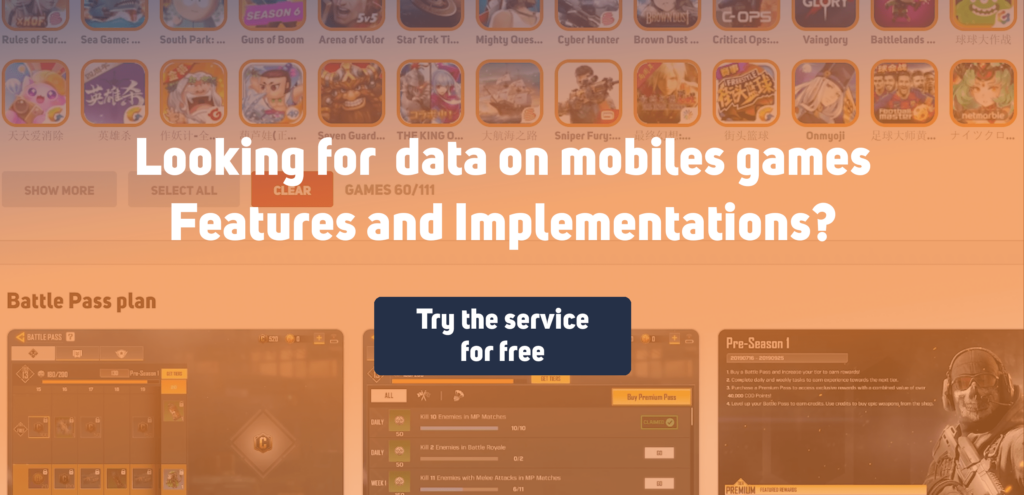· 13 min read
Battle Passes: The Latest Hot Trend in Mobile Gaming
Erno Kiiski
Chief Game Analyst at GameRefinery
Editor’s Note: This is an extended version of an article on the same topic that we published int Pocketgamer.biz, and was originally written by Erno Kiiski, Chief Game Analysts at GameRefinery – US. In his job, he’s played and analyzed hundreds of titles on a feature level, giving him a strong sense of the current western mobile game market. So, without further ado, we’ll let him take the lead.
A bit over a year ago, GameRefinery wrote a post about Battle Pass systems. Back then, this monetization mechanic was still brand-new with Fortnite, the first mobile title to popularize it among players. Even though other genres slowly started adopting the Battle Pass as well, it was mostly left to Battle Royale games. Now the mobile gaming market looks quite different, and you could argue that Battle Pass is here to stay – not only in Battle Royale but across the market.
In this blog post, our friends at GameRefinery focus on trend and popularity data for Battle Passes and look at a couple of the most interesting implementations they’ve seen so far.
The data and examples shown here are gathered from the GameRefinery service, which you can access here. If you’re interested in researching over 200 in-game features, their popularity, and implementations or checking out feature deconstructions of hundreds of games, you might want to pay a visit!
Let’s kick things off with a simple yet powerful graph:
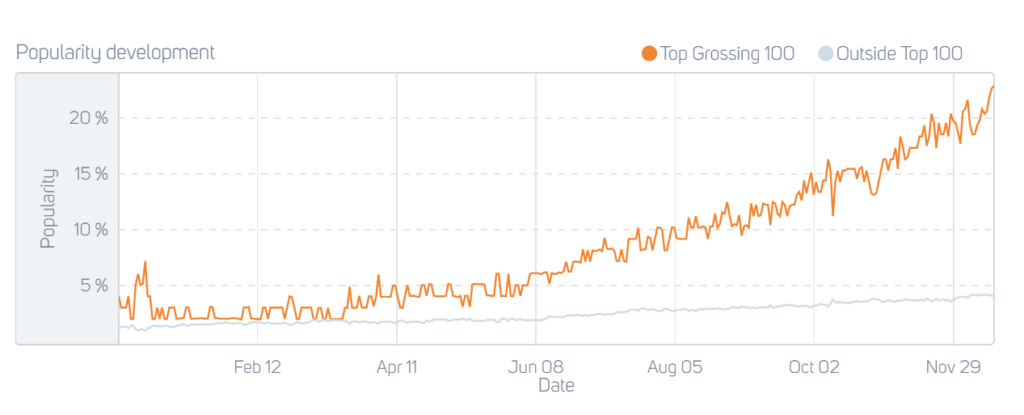
Battle Pass popularity in iOS US top grossing
What this hockey stick figure depicts is the Battle Pass system’s popularity among US iOS games and its strong upward trend during this year. At the beginning of the year, only a couple percent of the top-grossing 100 games had the feature implemented, but at the time of writing, 21% of US iOS top 100 grossing games already have a Battle Pass system up and running. During the last few months alone, the market has seen tons of different Battle Pass implementations – especially among the top 100 grossing titles.
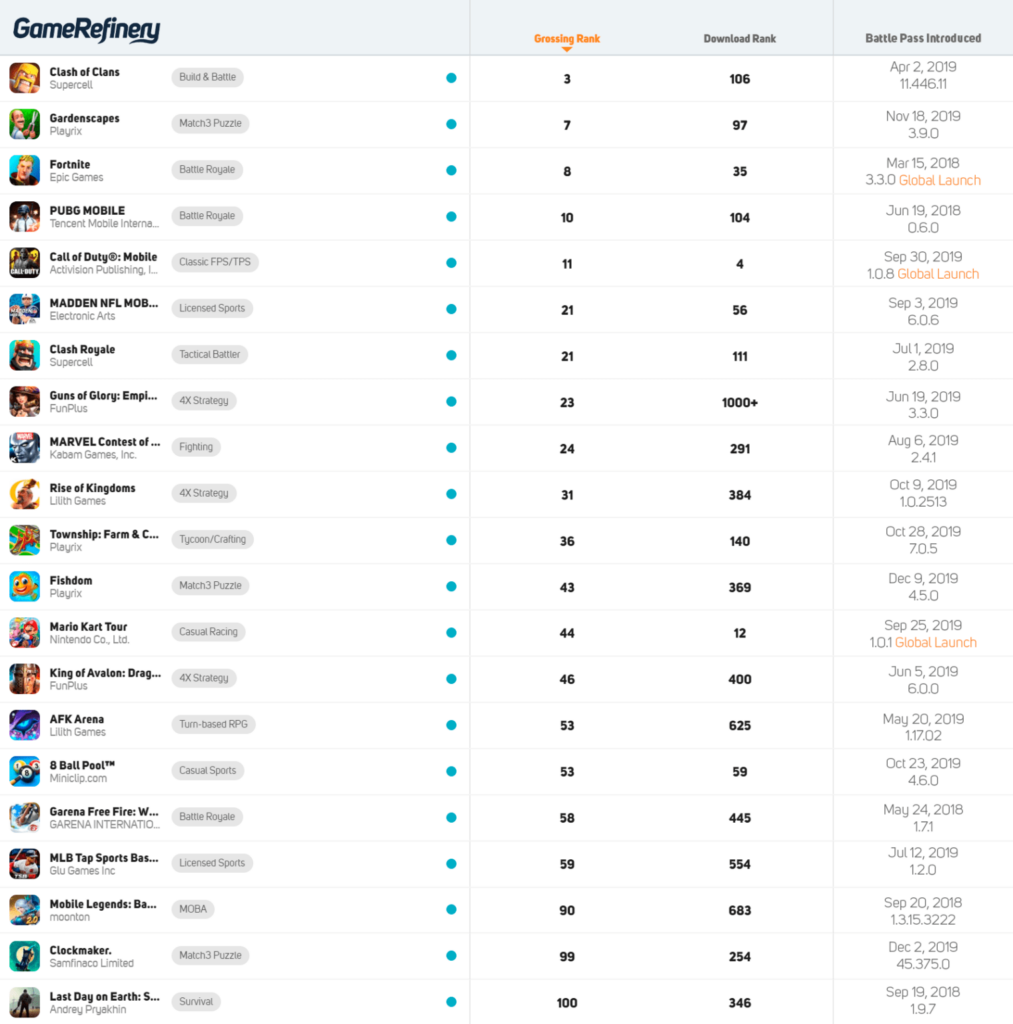
US iOS top grossing 100 games with Battle Pass
As discussed earlier, Battle Pass used to be a “one-genre only” feature, but as the picture above shows, there are plenty of different genres utilizing Battle Pass already.
There’s naturally more than one way to implement a Battle Pass, and some ways work better than others. It’s not an easy task to create a system that comes with appealing enough content while not cannibalizing your other monetization features. Or one that has just the right price points and solid progression curve for maximum retention. But if you manage to find the proper balance between all these elements, the result can be something extremely powerful, and your game’s monetization capabilities leap to new heights.
Here are some examples of how various titles that have implemented their Battle Pass recently; how the progression is built, what rewards are offered, and how much it costs to get your hands on these passes.
Clash of Clans
Clash of Clans implemented its Battle Pass system back in April this year. By doing so, this king of Build & Battle games became one of the first to join the Battle Pass trend outside the Battle Royale genre.
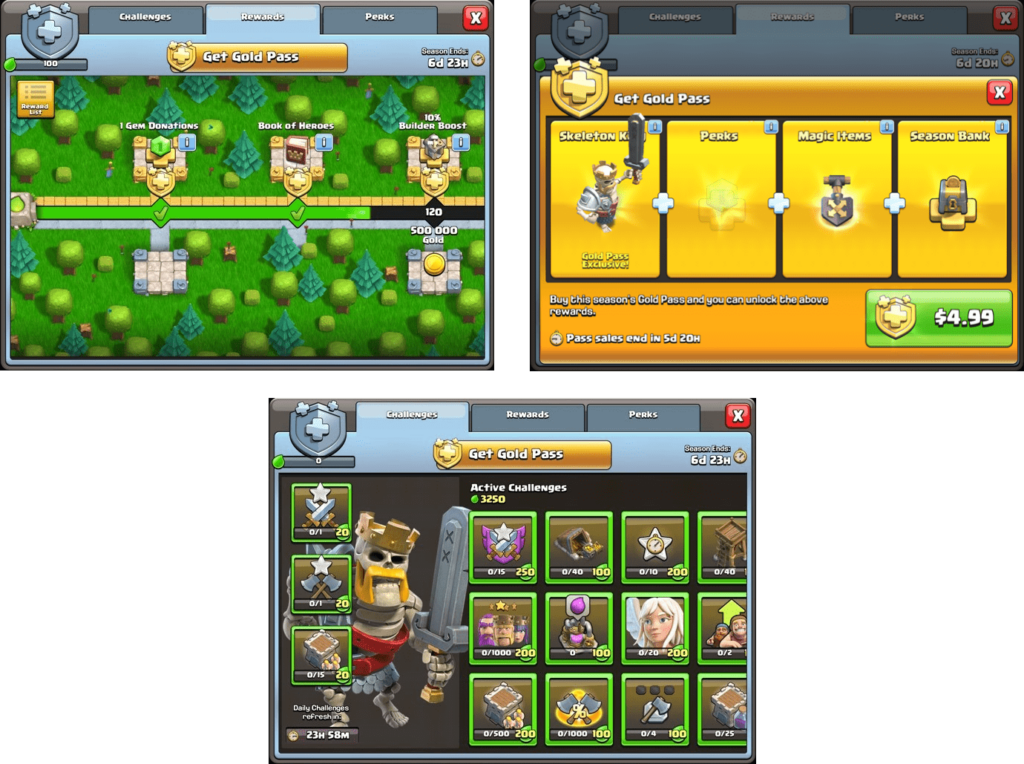
Price
$4.99
Season length
1 month
Progression
CoC built its Battle Pass progression around completing challenges. Players clear daily challenges and weekly “active challenges,” which players can complete at any point during the season with six new active challenges available every week. Completing these challenges reward players with challenge points that measure the progression of that Battle Pass season.
Rewards
Players can get their hands on wide variety of rewards, including heaps of gold, magic items (consumable boosts), special seasonal skins for hero characters, special Perks (which e.g. increase building speed for during that season) and a Season Bank, which is filled by loot earned from multiplayer matches that can be claimed after the season ends.
Is it worth it?
CoC’s Battle Pass had a huge impact on the game’s performance and no wonder: It brings a nice amount of value for the $4.99 price point. The progression system incentivizes players to come back on a daily basis to complete the challenges and engage with the game. Although the amount of exclusive rewards gained through CoC’s Battle Pass is relatively limited (in comparison to e.g. Fortnite), it still gives a decent extra value and doesn’t seem to cannibalize the game’s “normal” economy. Even though the price point is relatively low, it’s worth keeping in mind that the Battle Pass’ engaging and retaining nature helps increasing monetization of Clash of Clans indirectly through retention boost and the game’s other sinks.
Clash Royale
Supercell saw the excellent results of implementing a Battle Pass in Clash of Clans, so it wasn’t exactly a surprise when a Battle Pass system popped up in another Supercell hit game – Clash Royale.
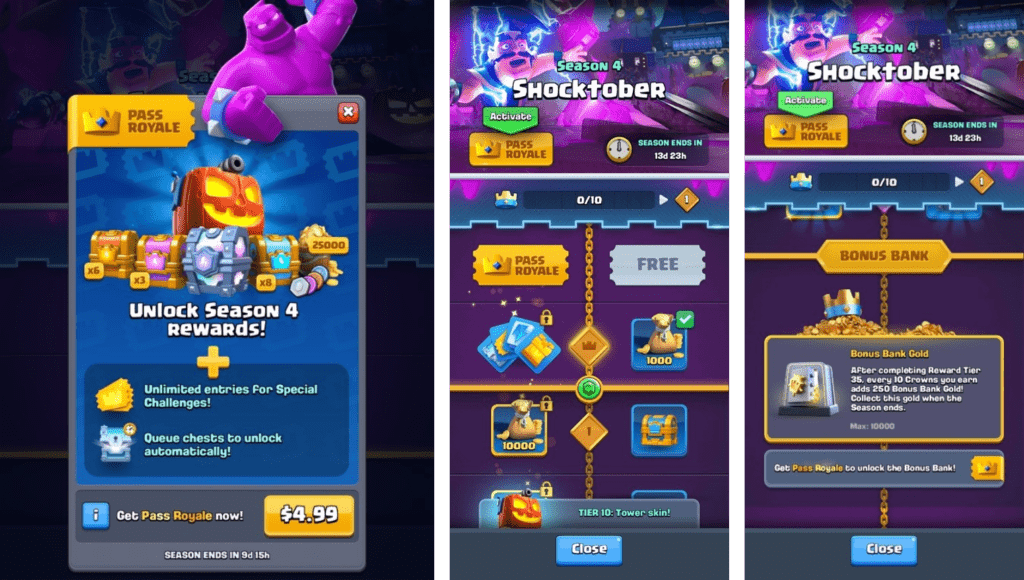
Price
$4.99
Season length
1 month
Progression
When you purchase the premium layer of Clash Royale’s Battle Pass, you instantly get unlimited entries to Special Challenges (events) and the possibility to queue your chest openings. The progression curve is actually really simple: as players earn crowns from winning matches, they also progress the Battle Pass further and unlock more rewards tier after tier.
Rewards
Chests with cards, gold, trade tokens, event specific emotes/tower skins, and “bonus bank.”
The Clash Royale Battle Pass only has 35 tiers, and once you’ve completed them all, every 10 crowns ads gold to the “Bonus Bank,” which players can claim after the season ends (similarly to Clash of Clans’ Season Bank).
Is it worth it?
Just like Clash of Clans, Clash Royale’s Battle Pass brings a lot of value for the relatively cheap $4.99 price point. However, I would argue that Clash Royale’s Battle Pass progression is not as engaging, because it is tied simply to winning matches and earning crowns. In other words, you don’t get to “interact directly” with the Battle Pass, but just come and claim the unlocked rewards every now and then. There are no daily/weekly quests that would push players to return to the game and engage retention. Apex Legends used a similar simplified progression structure during its first Battle Pass, but Respawn changed it quickly for a more engaging, quest-heavy approach for Season 2. It remains to be seen whether or not Supercell ends up doing the same.
Idle Miner Tycoon
As mentioned earlier, the Battle Pass started off as very genre-specific mechanic, but has recently swept across all sorts of games – both midcore and casual alike! One good example is Kolibri Games’ popular idle game Idle Miner Tycoon.
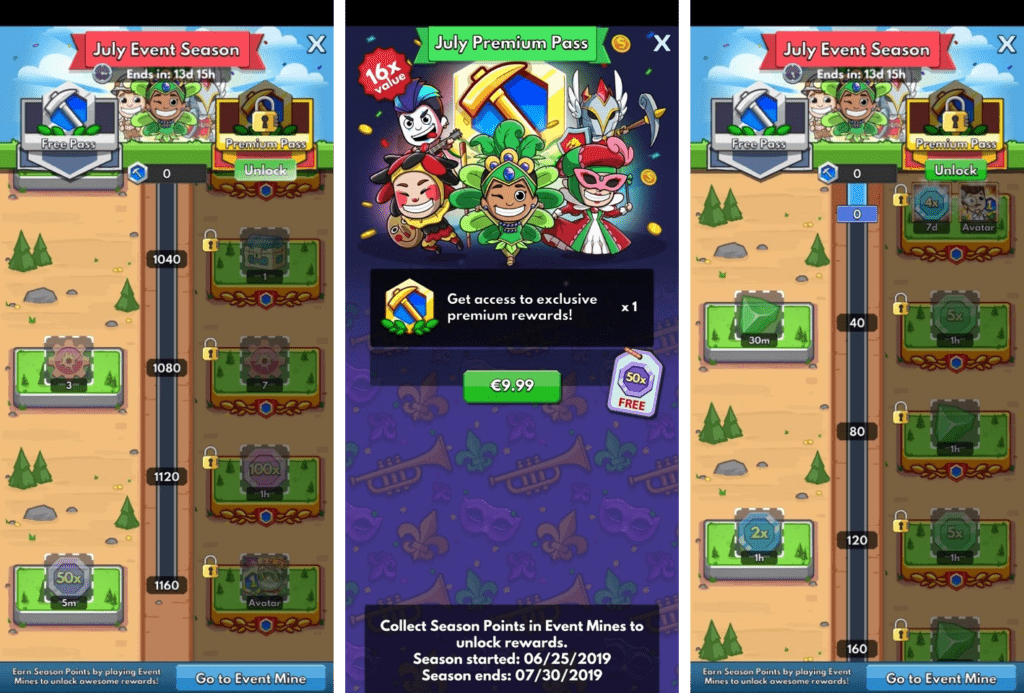
Price
$9.99
Season length
1 month
Progression
Idle Miner Tycoon’s Battle Pass is closely tied to the game’s ongoing event loop. In IMT, there are always live events running within “event mines” – special locations separate from the main game progression. Players earn Battle Pass season points from progressing in these event mines, a model that essentially ties event and Battle Pass progression together. During a single Battle Pass season there are multiple different events to participate in.
Rewards
Idle Miner Tycoon’s Battle Pass rewards players with different sorts of items that boost their income along with research points that players can use to buy permanent boosts from the research tree. In addition, there are a couple of basic chests with character shards and some event specific avatar icons for players to acquire through the Battle Pass.
Is it worth it?
Who would’ve thought a year ago that we have Idler games with a Battle Pass? I think it’s always exciting to see developers experimenting on how to implement a feature or mechanic across different genres. Personally though, I feel that Idle Miner Tycoon’s Battle Pass implementation feels more like a tacked on “extra reward layer” for the existing event system than its own comprehensive monetization mechanic.
Since the Battle Pass progression is earned simply by participating in events, it doesn’t feel as captivating and engaging as in some other games. It’s true that the Battle Pass gives players more reasons to participate in the said events, but the rewards earned are not as compelling- especially with this high of a price point. Moreover, the avatar icons and booster items don’t evoke a very strong “feeling of missing out” – one the biggest selling points, especially for cosmetic-driven Battle Passes.
Gardenscapes
Playrix has been one of the most successful publishers during recent years. One major driver behind their triumph is undeniably the way Playrix has approached the casual Match3 market on a feature level. For starters, they were in the forefront of popularizing the narrative/decoration meta layers in casual Match3 games – a bold move that was able to shake King’s saga games’ long-lasting dominance over the genre.
Now Playrix is once again pioneering a new feature in the genre, as it’s among the first developers in the West to bring the Battle Pass to casual Match3!
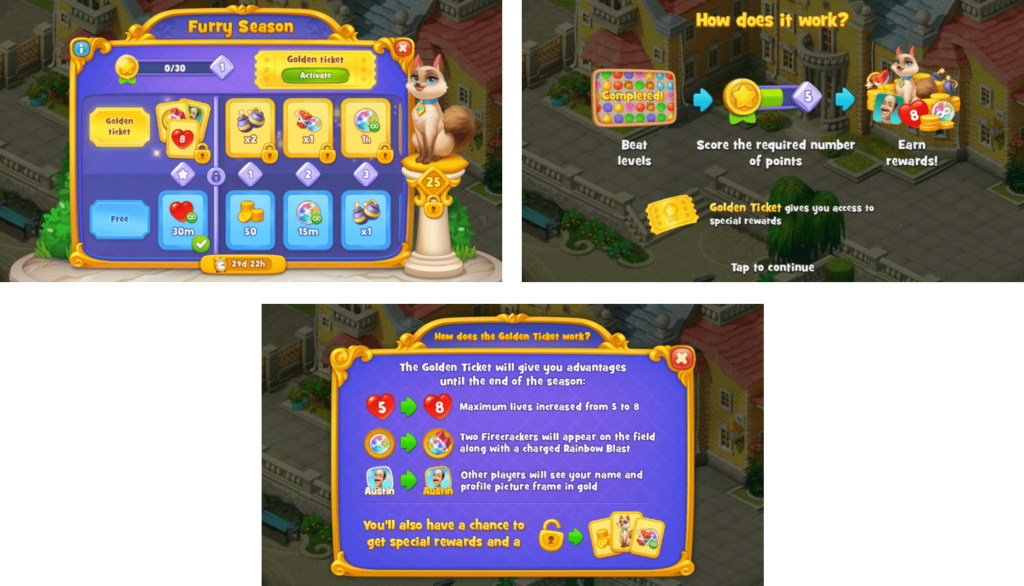
Price
$4.99
Season length
1 month
Progression
Gardenscapes’ Battle Pass feature is called Golden Ticket and its mechanics are rather straightforward: Players complete levels to earn “Season Points” and a specific amount of these points is needed to gain a threshold reward and progress onto the next reward level. The required number of points for each level-up increases the further you advance in the Season.
Rewards
Once the premium layer (i.e. Golden Ticket) is purchased, you don’t only unlock the higher tier rewards, but also receive immediate extra benefits straight away: your maximum amount of lives is increased, your profile icon turns golden and you start getting free boosters for the start of every level.
As you collect Season Points and reach reward thresholds you usually receive boosters and currency as rewards. However, a major selling point for Gardenscapes’ Battle Pass is that Golden Ticket holders gain access to exclusive season-bound characters. The first season’s unique reward is a pet cat which you can earn to your garden and it’s very likely we’ll continue seeing similar cute collectibles in the upcoming seasons as well.
Is it worth it?
Casual Match3 is another of those genres that sure isn’t the first one to pop in mind when talking about Battle Passes, but here we are. Gardenscapes’ Battle Pass is a nice addition to the game, as it brings an extra progression layer for players without overcomplicating the straightforward gameplay loops of a casual game. Even though the rewards it gives access to are not anything groundbreaking, it still manages to maintain a certain level of exclusiveness and is very likely to appeal to its core audience.
Mario Kart Tour
Mario Kart had its own version of Battle Pass implemented straight from launch. As Nintendo is well known for doing things its own way, it might not be surprising that Mario Kart’s brings a new twist to the mix with the “Gold Pass” feature.
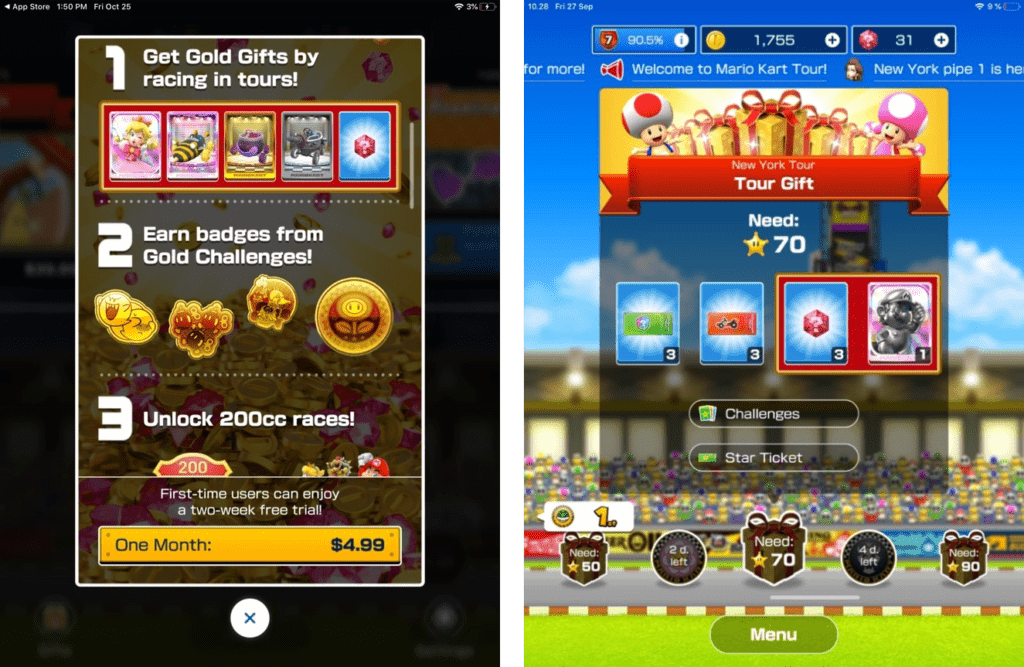
Price
$4.99 / month. Recurring subscription
Progression
Similarly to any Battle Pass, the Gold Pass unlocks the so-called “premium” reward track for players. Players acquire 1-5 stars per race based on their performance on tracks, and once enough stars are acquired, the next races and reward thresholds are unlocked.
One interesting difference from the norm, however, is that the Gold Pass uses a continuing monthly-based subscription, whereas with other Battle Passes you pay a single transaction for every season you want access to premium content. Therefore, it is kind of a mix between a Battle Pass and a recurring monthly subscription.
Another major difference to your normal Battle Pass stems from Nintendo’s decision to open the fastest racing mode only for Gold Pass subscribers. This makes Mario Kart Tour one of the only games to put an entire game mode behind a Battle Pass paywall, a move that has riled up some in the community.
Rewards
200cc game mode, premium currency, experience tickets, special badges for your player profile, kart/glider/character cards.
Is it worth it?
As Mario Kart had the Gold Pass right from the get go, it’s clear that the Battle Pass model is a big part of Nintendo’s monetization strategy for the game. It was quite a bold move to block the 200cc races behind a paywall, and it understandably caused a minor uproar. However, one might argue that it’s just a slightly faster playing mode – not something you absolutely have to have to enjoy the game.
I think the bigger problem lies with current premium content, which strikes me as rather plain and uninteresting. The only exclusive rewards you get with the Gold Pass are golden profile badges – not the most special and sought after vanity item type I’d say. The most interesting merchandise is safely stored in gachas, which are available to everyone – not just Gold Pass owners.
I expect that Nintendo will tweak the balance between Mario Kart Tour’s gacha economy and the Gold Pass based on the games’ performance after the big initial start. Maybe we’ll see some more appealing Gold Pass rewards in the upcoming seasons, as having more exclusive prizes would definitely make the $4.99 purchase more appealing. Things will get really interesting when the multiplayer modes are finally launched, and we’ll get to see how it affects the Gold Pass and its mechanics!
Summary
It’s no easy task to get all the bits and pieces of Battle Pass systems just right, but there is a clear trend that the market is trying hard to find ways to fit the feature across different genres. Some of these implementations have worked better than others, but overall it seems that a growing number of games have started eyeing the possibility of jumping aboard the Battle Pass train. One of the biggest upsides of doing so is naturally the highly engaging nature of the system. When done right, Battle Pass systems can have a tremendously positive effect on your game’s retention and monetization – both directly and indirectly.
As an addition to Battle Pass systems, auto-renewable subscription models have also started appearing within mobile games in growing numbers. When combined with the fact that there are constant legal investigations and regulations hovering around loot boxes/gachas, it might just be that subscription-based models are the next dominators of mobile game monetization. This is still early speculation, but the strong trend of subscription-based models is indisputable, and it seems that at least Battle Passes are here to stay.
If you want to dig deeper into the games presented here or for example, research all the different Battle Pass implementations of dozens of titles, you can sign up to GameRefinery’s service here.
Fancy some more reading? Check out some of GameRefinery’s other articles:
